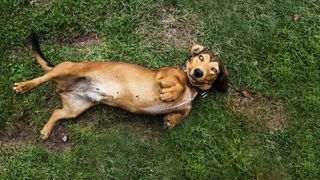The first step to fixing dead grass is a little light detective work. You need to find out exactly why your lawn is suffering. The good news is that most of our most common lawn problems have pretty simple solutions. So once you know what’s going on under the soil’s surface, you’ll know how to fix the problem so you can get back to maintaining your lush, green lawn with the best gas lawn mowers (opens in new tab) or the best electric lawn mowers (opens in new tab). Whether it’s a pest, a disease, the weather or your pet that’s to blame, you can fix patchy grass (opens in new tab) by reseeding or re–turfing. Alternatively, there are also other ways to give your lawn the appropriate treatment to help it recover.
How to fix dead grass
Whether you’re a perfectionist or you happily tolerate moss and a few weeds, patches of dead grass are a problem. Occasionally they can be symptomatic of a problem that could, in time, kill off your entire lawn. So it pays to get to the root of the problem fast. We asked consultant David Hedges-Gower, founder of the Lawn Association, for his help to solve this common lawn problem. “It’s all about being your own lawn expert,” he says. Dog urine The most common cause of lawn die-off is your lovable pet, says David. “A patch of dog urine is a huge shot of ammonia,” says David. “This is a type of fertilizer, hence the green ring. But the concentration in the middle is enormous.” So how to fix it? You can aerate the soil with a hollow-tine fork and flush through with water to help reduce the level of ammonia in the soil. Smaller lawn pests Chafer grubs and leatherjackets are perhaps the most damaging lawn pest. Fat, white chafer grubs are the larvae of chafer beetles, which mature between spring and autumn. They feed on grass roots, causing yellow patches. Then, birds, foxes or raccoons might subsequently root around to dig out the tasty grubs. The result can be devastating. Special nematodes (Heterorhabditis bacteriophora), effective only in warm weather, are a biological treatment. However, depending on the damage, you might need to reseed or returf. “I prefer seed,” says David. “With seed you get three or four varieties. This means that you’ll end up with a domination of the grass seed that will enjoy growing in your particular soil.” Grey-brown leatherjacket grubs (the larvae of crane fly) can have a similar effect on your lawn. Cover the affected area with black plastic overnight and the next day they will have come to the surface. Again, treat in summer with nematodes specific to leatherjackets. Lawn diseases Most lawn diseases hit in wet weather, from late summer to winter. Lawn rust disease, for example, turns a lawn yellow and you’ll see orange spores on the undersides of grass blades. It’s rarely a big problem, but your best solution is to mow regularly and remove the clippings. You can also improve air circulation by pruning overhanging shrubs and trees. Red thread is a fungal disease that can appear in autumn or wet summers. Look closely and you’ll see its pinkish tinge.”It only kills leaf blades, not the plant,” says David, but you can help affected patches to recover by applying liquid iron. Scarifying and aerating will improve drainage and help to guard against future attack. Patches of yellowing, dying grass in wet weather could be the fungal disease fusarium patch, aka snow mold. You might see a cottony fungal growth, too. Again, the best remedy is to improve aeration, drainage and airflow by scarifying, aerating and cutting back overhanging tree growth. “An application of liquid iron will dry the plants and stop the fungus feeding off the moisture,” advises David. ‘Dead’ grass might not necessarily be dead If your grass has irregular brown patches in dry weather, it could be drought that’s the cause. This might be more visible around trees or along the run of their roots. How you deal with this will largely depend on you, although David advises taking a relaxed approach. “Grass has adapted over the millions of years it’s been here. Water is a finite resource and grass is adaptable. Think of it as being in temporary hibernation; it will return once the rains come.” Discover more guides for the garden… Best chainsaws (opens in new tab) Best pool heaters (opens in new tab) Best swim spas (opens in new tab) Best water heaters (opens in new tab) Best patio heaters (opens in new tab)









